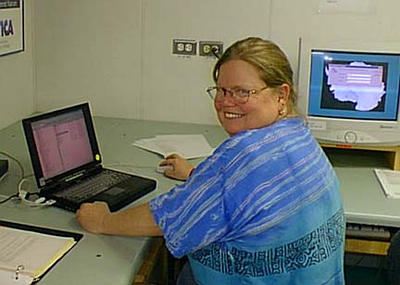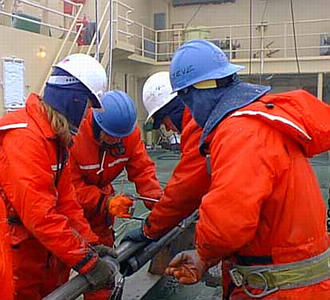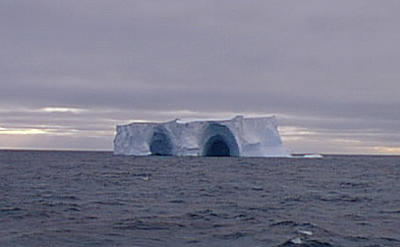
|
|
16 March, 1999
March 16, 1999
Hello from the Palmer! We've been conducting multibeam surveys and coring
all day today. We're still finishing up our work in Eltanin Bay, but I bet
that we won't be here when I wake up in the morning. After dinner, Mike
(the Mate) called me up to the bridge. He wanted to show me some areas
where the water looked a little brown or orange. He explained that those
areas were actually krill swarms! In other words, there were so many krill
in the water that they actually made the water look a different color! It
was pretty neat.
John also said that he saw quite a few Cape pigeons flying around today.
Another name for these birds is Cape petrels. They are often called Cape
pigeons because they peck at the surface of the water (like a pigeon pecks
at the ground) to get squid, krill, and fish. Based on what I saw today, I
bet they were eating some krill! Well, this brings us to the question for
today: "What are some of the other birds that you find in Antarctica
(besides penguins)?"
There are 43 species of birds that breed within the limits of the Antarctic
Convergence. Penguins make up seven of those species. The most numerous
of all southern birds, in both numbers and species, are the petrels. There
are 24 species of petrels found down here . . . from the Wandering
albatross to the Fulmar prion to the Blue petrel. These are all sea birds
which have some common characteristics. Such characteristics include
webbed feet, dense feathers, a layer of fat beneath their skin, and tubular
nostrils. The also have some method in which they can secrete all of the
salt that they take into their bodies as they collect their dinners. While
some sea birds secrete the brine through the tubes in their nostrils,
others secrete the brine from glands above their eyes and allow the tubes
to help drain it away.
We have seen lots of Antarctic petrels. They are brown and white birds
that are common near pack ice. Antarctic petrels spend the austral winter
at sea, and return to their breeding grounds during the month of November.
They only breed on the continent of Antarctica and on some of the most
southerly islands. It is estimated that there are several million pair of
Antarctic petrels, and they are especially common around the Ross Sea.
Although I haven't seen any albatrosses yet, I would love to see a
Wandering albatross. Mike said that we might see some after we leave the
Antarctic peninsula and are heading north across the Drake Passage.
Wandering albatrosses are the world's largest flying birds (largest
wingspan). The weigh over 20 pounds, and can be 53 inches long with a
wingspan of 142.5 inches! They spend most of their adult life gliding with
the winds that circumnavigate the Southern Ocean. These birds eat
primarily squid and fish, although they will poke around in floating
seaweed for some small crustaceans. Normally, they come ashore only to
breed. They return to their breeding grounds every other November to lay a
single egg.
There are 12 species of land and shore birds that live south of the
Antarctic Convergence. Only three of them, however, live in this area
permanently . . . the others migrate north for the Antarctic winter. There
is only one species of true gull that breeds in the Antarctic region. It
is called the Dominican gull (or the Kelp gull), and it can also be found
in South Africa, South America, and New Zealand. Although Kelp gulls do
fish for krill, they rely primarily on limpets for their food. They
swallow the limpets whole, then regurgitate the shells intact at a later
time. The chicks, which are fledged in mid-January, feed on small fish
like Antarctic herrings. Although the adult birds will winter in
Antarctica, adolescent juveniles migrate to South America for their first
winter.
Well, I would like to introduce one more ASA member before we finish for
the day. There are about 40 computers aboard the Palmer. It takes a lot
of work to keep those computers running and to help the scientists capture
and understand all of the data that is stored on them. On this cruise, ASA
has provided a Senior Analyst and two Network Administrators to help us
out. Our Senior Analyst is Kathleen Gavahan. She grew up in Las Vegas,
New Mexico (not Nevada). After attending high school, she graduated from
the New Mexico Institute of Mining and Technology, in 1974, with a B.S. in
Mathematics. Immediately after her graduation, she began working as a
geophysicist; first for Amoco and then for Home Petroleum in Denver. After
the drop in oil prices in the 1980s, she was laid off. Kathleen was then
hired by Western Geophysical in Denver as a geophysical programmer. At the
same time that she was working her way up to becoming the leader of her
programming department, she was also taking night classes to earn her M.S.
in Computer Information Systems. She finished her Masters in 1995, and her
reward to herself was a recreational cruise to Antarctica. The cruise
stopped at Palmer Station as part of its itinerary, and it was at that time
that Kathleen found out about Antarctic Support Associates. She was hired
by ASA nine months later, and began working with the Database Programming
Group in the Denver office. She spent some time at McMurdo Station that
winter (McMurdo's summer), and then transferred to the Marine Group, where
she has remained since 1997. Kathleen has spent time aboard both the
Laurence M. Gould and the Nathaniel B. Palmer as a Senior Analyst. She
spends nearly half of her time working back at the Denver office writing
computer programs and analyzing data. She loves Antarctica so much that
she has even vacationed in the area. Kathleen also loves to travel all
over the world, having visited places such as China, the Galapagos Islands,
Ireland, Morocco, and Kenya.
Tomorrow, we'll look at the jobs of the two Network Administrators. In
addition, we'll look at the question, "Who was Ernest Shackleton?" Things
are going very well down here. I just can't believe that we have less than
two weeks left. The days are really flying by! It's sure great to hear
from so many of you . . . I really appreciate all of the email and the
questions. Until tomorrow . . .
Kim Giesting
Latitude: 72 degrees 00 minutes South
Longitude: 81 degrees 55 minutes West
Temperature: -1.4 degrees C
Barometer: 970.6 mb
Wind Speed: 37.3 knots
Wind Direction: 90 degrees (from the East)
Sunrise: 06:04
Sunset: 19:20

Kathleen is the Senior Analyst on our cruise.

When we take a core, the sediments usually don't fill the entire liner. Before we cap the ends, we use a hacksaw to cut off the extra plastic.

This morning we saw a very unusual iceberg. The waves have eroded two caves in the ice. These tunnels don't go all the way through the iceberg, but they are very deep.
Contact the TEA in the field at
.
If you cannot connect through your browser, copy the
TEA's e-mail address in the "To:" line of
your favorite e-mail package.
|
